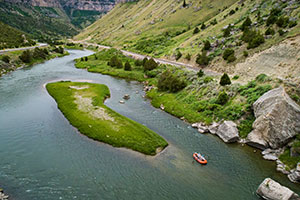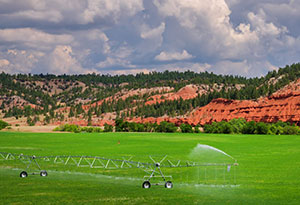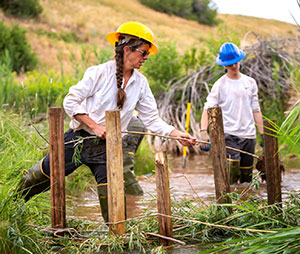
Contact Us
Institutional Communications
Bureau of Mines Building, Room 137
Laramie, WY 82071
Phone: (307) 766-2929
Email: cbaldwin@uwyo.edu
UW Wins $20M Grant to Study Climate-Driven Changes to State’s Water Suppl
Published May 16, 2022

A whitewater raft moves down the Wind River in central Wyoming’s Wind River Canyon.
A five-year, $20 million grant from the National Science Foundation will allow UW
researchers to quantify how a changing climate in one of the nation’s key headwater
regions is likely to affect streamflows, aquatic ecosystems and vegetation -- and
the communities and people who depend upon them. (UW Photo)
A five-year, $20 million grant from the National Science Foundation (NSF) to the University of Wyoming will allow researchers to work with Wyoming’s communities to deal with expected significant and lasting changes in water availability.
Through fieldwork and high-performance computing, researchers will quantify how a changing climate in one of the nation’s key headwater regions is likely to affect streamflows, aquatic ecosystems and vegetation -- and the communities and people who depend upon them.
“This project has the unique goal of linking high-performance and data-intensive computing with both environmental field research and social science,” UW President Ed Seidel says. “It will establish new innovative capacity in Wyoming to address the ecological and socioeconomic consequences of climate-driven changes to the water supply. And it will establish Wyoming as a key player in climate change research and integrated Earth system modeling.”
The grant was announced today (Monday) through NSF’s EPSCoR (Established Program to Stimulate Competitive Research) program, which supports efforts to enhance research, science and mathematics education, and workforce development. The award comes on the heels of two other five-year, $20 million NSF grants to UW in 2012 and 2017 that stimulated wide-ranging research into Wyoming’s water resources and microbes in the state’s landscapes.
The project’s official name is WY-ACT: Wyoming Anticipating Climate Transitions. It will include establishment of a Laboratory for Regional Earth System Modeling; the launch of a Center for Climate, Water and People; and investment in new capabilities centered at the UW-National Park Service (NPS) Research Station in Grand Teton National Park. Five new faculty positions will initially be supported by the federal grant.
The highly interdisciplinary project is led cooperatively by five principal investigators already at UW: Brent Ewers, a botany professor and director of the Biodiversity Institute and Wyoming EPSCoR; Bart Geerts, a professor of atmospheric science; Corrie Knapp, an assistant professor in the Haub School of Environment and Natural Resources; Bryan Shuman, a professor of geology and geophysics; and David Williams, a professor of botany.
“These highly accomplished faculty members are leading research that will quantify interactions between social and natural systems and their resilience to climate-induced disturbances in a critically important headwaters region of the western U.S.,” UW Provost and Executive Vice President Kevin Carman says. “The project activities and investments in critical and sustainable facilities and personnel will enhance Wyoming’s research competitiveness and more effectively support the needs of people in Wyoming and the region.”
“The broader impacts of the project will improve existing programs and innovate new approaches for education, workforce development and new business ventures on the Wind River Indian Reservation and in rural areas across Wyoming that are vulnerable to climate-induced disturbances,” says Diana Hulme, UW’s interim vice president for research and economic development. “These outcomes will be achieved by increasing entrepreneurship; workforce training in computation and data science; field-based undergraduate research experiences; testing novel approaches to graduate education; improving communication using journalism; and involving K-12 educators directly.”

Center-pivot sprinklers water a field near the Belle Fourche River just east of Hulett.
A major UW research project aims to help Wyoming communities deal with projected significant
and lasting changes in water availability. (UW Photo)
The project also will expand research opportunities with state, regional and national partners -- including the National Center for Atmospheric Research-Wyoming Supercomputing Center near Cheyenne; the Wyoming Innovation Partnership, including Wyoming’s community colleges; the Eastern Shoshone and Northern Arapaho tribes of the Wind River Indian Reservation; WEST Inc., a Cheyenne-based business that provides environmental and statistical consulting services; and multiple state and federal agencies.
“This project provides a unique opportunity for future data scientists to work alongside leading researchers who are collaborating on real-world solutions to water supply issues in the state,” says Shay Howlin, WEST Inc.’s board president. “This is an excellent way to prepare young Wyoming professionals for technical careers.”
A number of other UW units also are involved, including faculty in multiple departments from the College of Engineering and Applied Science, the College of Arts and Sciences, the College of Agriculture and Natural Resources, the College of Education, the Wyoming Geographic Information Science Center, the Advanced Research Computing Center, the Science Initiative and the UW-NPS Research Station. The project promises to raise UW’s national profile and research competitiveness.
“An interdisciplinary research approach to understanding and solving these critical issues in Wyoming has national significance because the framework of using process-based, high-resolution models of the biophysical environment and human interactions can be readily adapted to other locations,” says Parag Chitnis, UW’s incoming vice president for research and economic development.
Timely Research
Western North America and the Rocky Mountains -- including Wyoming, where the three major river basins of the western U.S. converge -- are experiencing historic drought conditions. The warming climate, reflected for years in the decline of glaciers in the Wind River Mountains and the Tetons, is projected to result in reduced wintertime snowpack, earlier snowmelt and sharp declines in soil moisture, streamflows and water storage. This compounds the risk of large-scale forest die-offs, wildfires and other ecological disturbances.
“Because these trends are projected to continue, water availability will become less certain and predicable, even while society’s demand for water is likely to increase,” says Shuman, the professor of geology and geophysics who contributed to the recent Greater Yellowstone Climate Assessment. “The rapidly unfolding changes have become the most significant and complex challenge facing people in the western U.S., including Wyoming.”
“Wyoming is heavily dependent on natural resources, and the impacts of climate change on water supply -- and associated shifts in terrestrial and aquatic ecosystem functioning -- are likely to be felt across all sectors of Wyoming’s society and economy, affecting the lifestyles and livelihoods in every community,” says Knapp, the Haub School faculty member who will serve as the inaugural director of the project’s Center for Climate, Water and People. “These include impacts on agriculture and tourism.”
WY-ACT aims to use data collection and computer modeling to simulate future impacts on the water supplies of communities around the state, then share that information with state and community leaders. The computer models will include data regarding the climate; watershed hydrology; terrestrial and aquatic ecosystems; and social and economic systems. Input will be sought from numerous stakeholders through community workshops, focus groups, interviews and other contacts to develop the models.

Members of UW’s Wyoming Conservation Corps -- Beth Vanderborgh and Nic Fadial -- install
an artificial beaver dam along Red Canyon Creek at the Nature Conservancy’s Red Canyon
Ranch south of Lander. The hope is to help restore the stream into a more natural
form, similar to when beavers were more prevalent. The impacts of climate change on
Wyoming’s headwaters are the focus of a major new study led by UW. (UW Photo)
“The modeling will provide insights on how the globally warming climate we are experiencing now and in coming decades will impact water, ecosystems and economic systems in Wyoming while also offering a tool to assess alternative policies that can manage environmental and economic transitions,” says Geerts, who will oversee the establishment of the Laboratory for Regional Earth System Modeling.
Fieldwork and data collection are slated to take place at a variety of locations, including across the Continental Divide at Union Pass, Dinwoody Lakes and Lake of the Woods in the Wind Rivers; Jackson Lake and areas of Grand Teton National Park; Boysen Reservoir; and New Fork Lakes and adjacent ranchlands in the Upper Green River Basin. WY-ACT will collaborate with Central Wyoming College (CWC), whose Alpine Science Institute has been studying the Dinwoody Glacier for a number of years, to expand backcountry research opportunities in that area of the Wind Rivers.
“Our approach for fieldwork and data collection is highly integrated; we will be observing the way changes in water availability influence natural ecosystems and human behavior at the same locations in a concerted way -- and then using the integrated data and information to inform the modeling,” says Williams, who will serve as the project’s lead scientific investigator. “Most importantly, we will be making observations and collecting data in close collaboration with stakeholders.”
Key collaborators in the project are the Eastern Shoshone and Northern Arapaho tribes, as their participation is crucial in developing approaches to the research and communicating outcomes. CWC and the tribes have been part of the planning of WY-ACT for the participation of tribal students and faculty, as well as for building capacity with tribal programs.
“Water is sacred not only as part of our culture, but vital to subsistence, plants, animals and survival,” says Tarissa Spoonhunter, an associate professor of American Indian studies at CWC. “Our holistic view of water and the effects of climate change are crucial on the Wind River reservation. As one of the senior water holders in a headwater state, being a part of WY-ACT creates opportunity for sharing of knowledge and partnership.”
Ewers, who leads the WY-ACT project management team, sees tremendous potential for the project to build the state’s research capacity and benefit Wyoming communities.
“Our overarching goal is to strengthen the capacity to conduct research across the boundaries of climate science, hydrology, ecology and social science -- and provide opportunities for Wyoming’s communities and stakeholders to collaborate with the core research and benefit more directly from the findings,” Ewers says. “Our primary objective is to generate cross-cutting observations, datasets and understanding that will support the adaptive capacity of Wyoming’s rural communities and economies in the face of rapidly changing and uncertain climate conditions.”
Contact Us
Institutional Communications
Bureau of Mines Building, Room 137
Laramie, WY 82071
Phone: (307) 766-2929
Email: cbaldwin@uwyo.edu
